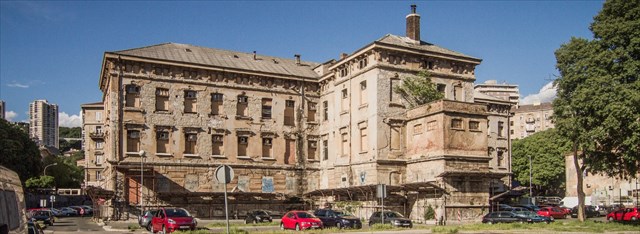
Za uspostavljanje Tvornice duhana u Rijeci ključan je bio carski patent donesen 20. studenoga 1850., koji se odnosi na monopol u proizvodnji duhana. Patent je stupio na snagu u Ugarskoj, Transilvaniji, Hrvatskoj, Slavoniji i Vojnoj krajini u ožujku 1851. godine. Sama mađarska vlada je 24. svibnja 1851. za 100.000 zlatnih dukata otkupila zgrade stare Rafinerije šećera i u postojećoj infrastrukturi propale Rafinerije šećera započela proizvodnju duhana. Prvi ravnatelj tvornice bio je Josip Dechler, a nakon njega dolazi Franjo Skodnik. Tvornica će prve izmjene pretrpjeti tek krajem šezdesetih kada se kompleks proširuje historicističkom trokatnicom tzv. T-objektom. U toj je zgradi 1867. pokrenuta proizvodnja Virginia cigara. Tvornica duhana koristila je i prostore tzv. H-kompleksa, odnosno nekadašnju pogonsku zgradu Šećerane. Paviljoni su međusobno bili spojeni aneksom pa su pritom tvorili tlocrtni oblik slova H, odakle proizlazi naziv. Tvornica duhana poznata je po broju radnika koje je zapošljavala. Godine 1884. u njoj je bilo zaposleno 2.600 radnika, većim dijelom žena. Spominju se i jako dobri uvjeti za rad. Radnici su imali dnevni objed, zdravstveni sistematski pregled, plaćeno bolovanje i razne druge pogodnosti. Godišnja proizvodnja cigareta bila je značajna – 1880. godine 150–170 milijuna, a već 1890. čak 250 milijuna cigareta. Nakon Prvoga svjetskog rata i pada Monarhije, tvornica nastavlja djelovati sa smanjenim proizvodnim kapacitetom. Radni uvjeti drastično se narušavaju i sve su češći štrajkovi radnika. Tako je u siječnju 1925. pokrenut štrajk za čije je gušenje bila angažirana vojska. Tvornica prestaje s radom tijekom Drugoga svjetskog rata, a posljednji njezin ravnatelj bio je Augusto Vannini. Nekoliko godina nakon prestanka rada tvornice, u kompleksu će od 1945. do 1995. djelovati Tvornica motora i traktora Rikard Benčić.
RI EPK 2020.
RIJEKA KROZ POVIJEST
ŠTO POSJETITI?
qRIJEKA


Crucial for the establishment of the Tobacco Factory in Rijeka was the imperial patent referring to the monopoly in the production of tobacco, issued on 20 November 1850. This patent became effective in Hungary, Transylvania, Croatia, Slavonia and the Military Krajina in March 1851. On 24 May 1851, the Hungarian government bought the buildings of the former Sugar Refinery for 100,000 gold ducats and started producing tobacco in the existing infrastructure of the collapsed Sugar Refinery. The first director of the company was Josip Dechler, followed by Franjo Skodnik. The plant did not undergo further changes until the late 1860s, when the complex was expanded by a historicist four-storey building called the T-object. In 1867, the production of the Virginia cigars started in this building. The Tobacco Factory also used spaces of the former factory buildings of the Sugar Refinery, the so-called H-complex. The pavilions were interconnected with an annexed building forming the letter H. The Tobacco Factory was renowned for the high number of workers it employed. In 1884, it had 2,600 workers, mostly women. The working conditions are reported to have been very well. The workers enjoyed a daily meal, physical health examinations, paid sick leave and various other benefits. The annual production of cigarettes was significant. In 1880, 150-170 million cigarettes were produced and, in 1890, the number was already at 250 million. After the First World War and the fall of the Monarchy, the factory continued to operate with a reduced production capacity. The mentioned working conditions drastically worsened and the number of workers’ strikes increased. In January 1925, the workers launched a strike and it was necessary to bring in the Army in order to break it. The factory closed its doors during World War II and the last director of the company was Augusto Vannini. Several years after the closure of the factory, from 1945 to 1995, the complex housed the Rikard Benčić Factory of Engines and Tractors.
RIJEKA ECoC 2020
RIJEKA THROUGH HISTORY
WHAT TO SEE?
qRIJEKA
